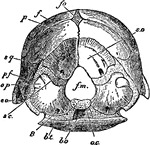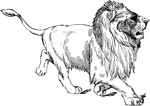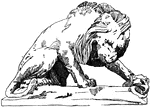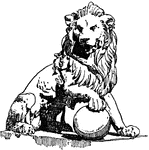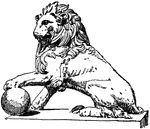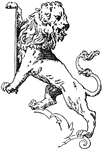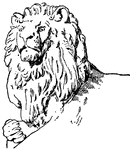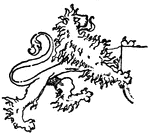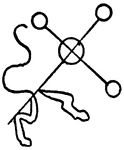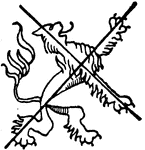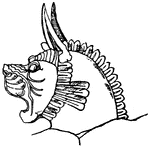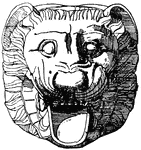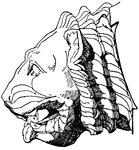Front View of the Colossal Statue on a Pier at the Luxor Temple
Instead of columns, square piers are not infrequently introduced in the tombs. In structural buildings…

Entrance to the Great Temple at Abu Simbel
In 1959 an international donations campaign to save the monuments of Nubia began: the southernmost relics…
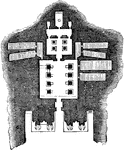
Floor Plan of the Great Temple at Abu Simbel
In most rock-temples a court, which is sometimes hewn out of the rock, or a covered vestibule forms…

Cross Section of the Great Temple at Abu Simbel
In most rock-temples a court, which is sometimes hewn out of the rock, or a covered vestibule forms…
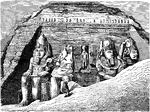
Entrance of the Great Temple at Abu Simbel
Four colossal 20 meter statues of the pharaoh with the double crown of Upper and Lower Egypt decorate…

Hall Section of the Great Temple at Abu Simbel
This image shows how the middle passage is made more imposing by the arrangement of elevating the columns…

Guilloche Ornament Painted on Burnt Clay, from the Ruins of Nineveh
Guilloche, usually spelled without the acute accent on the final e, describes a repetitive architectural…
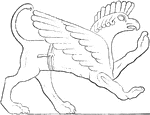
Sculptured Griffin from the Sculptures in the Ruins of Nineveh
A representation of an Assyrian griffin that adorned their buildings prior to the Persian conquest.
Sculptured Ornamental Border from the Ruins of Nineveh
Over the Winged Bulls were painted other acts of the king surrounded by his eunuchs and warriors, and…

Pillar on a Lion's Back
In the fragment of a relief from Kuyunjik columns occur which rest on a cushion-shaped base on a lion's…

Capital and Entablature from the Rock Tomb of Darius
The columns in the ruins of Persepolis are circular and slender, and have capitals and bases. The capital…

Gastrotricha
A small group of fairly uniform animals which live among Rotifers and Protozoa at the bottom of ponds…

The Lion Gate at Mycenæ
Remains of the circular walls round towns and palaces, which are known under the name Cyclopean, exist…
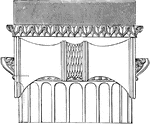
Side View of the Ionic Capital from the Temple of Minerva Polias at Priene
These volutes, or scrolls, when viewed from the side, appear to meet in the middle, and form a wavy…
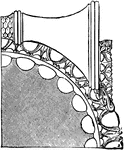
Top View of the Ionic Capital from the Temple of Minerva Polias at Priene
These volutes, or scrolls, when viewed from the side, appear to meet in the middle, and form a wavy…
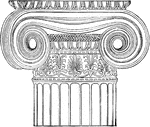
Ionic Angle Column from the Temple of Minerva Polias at Athens, Front
The good effect of the Ionic capital is really only produced by the front-view. It seems calculated…

Ionic Angle Column from the Temple of Minerva Polias at Athens, Side
The good effect of the Ionic capital is really only produced by the front-view. It seems calculated…

Mutule, Side View
Rectangular block under the soffit of the cornice of the Greek Doric temple, which is studded with guttae.…

Mutule, Front View
Rectangular block under the soffit of the cornice of the Greek Doric temple, which is studded with guttae.…

Assyrian Lion
The Assyrian Lion is on a glazed clay slab at a royal palace in Khorsabad, Assyria during the 6th century…

Lion Supporting Shield
The Lion supporting shield is also called "il Marzocco" in Italian. It is a sculpture designed by Donatello…

Sleeping Lion
The Lion Sleeping is a monument to Pope Clement XIII is found in St. Peter's, Rome is designed by Canova.

Lion Coat of Arms
This Lion Coat of Arms is designed with inlayed marble work. It was found in St. Croce, Florence, Italy,…

Lion Coat of Arms
This Lion Coat of Arms is designed with an intarsia panel. It was found in St. Maria Novella, Florence,…

Tomb in Wertheim
The Lion Tomb in Wertheim in Germany was designed during the 16th century by Johann of Trarbach.

Greek Griffin
The Greek Griffin is associated with Antiquity and fire, usually appears on Candelabras and friezes.…

Roman Griffin
The Roman Griffin has the body of a Lion and the head and wings of an Eagle. The Griffin is usually…

Griffin Renaissance
The Renaissance Griffin is associated with Antiquity and fire, it appears on Candelabras and friezes.…

Winged Lion
The Winged Lion is shown on the tomb of Loys de Bresze in the Rouen Cathedral during the 16th century.
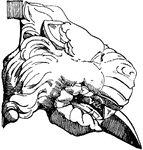
Gargoyle Lion Head
This Gargoyle Lion Head is made out of terracotta and is found in Athens, Greece.

Antique Lion Head
This Antique Lion Head shows the front view of the antique head. This Lion's Head is found at the Vatican.

Antique Lion Head
This Antique Lion Head shows the side view of the antique head. This Lion's Head is found at the Vatican.
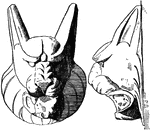
Lynx Head
This Lynx head is shown from its front and side view. It is an Antique Gargoyle, found in the Vatican.
